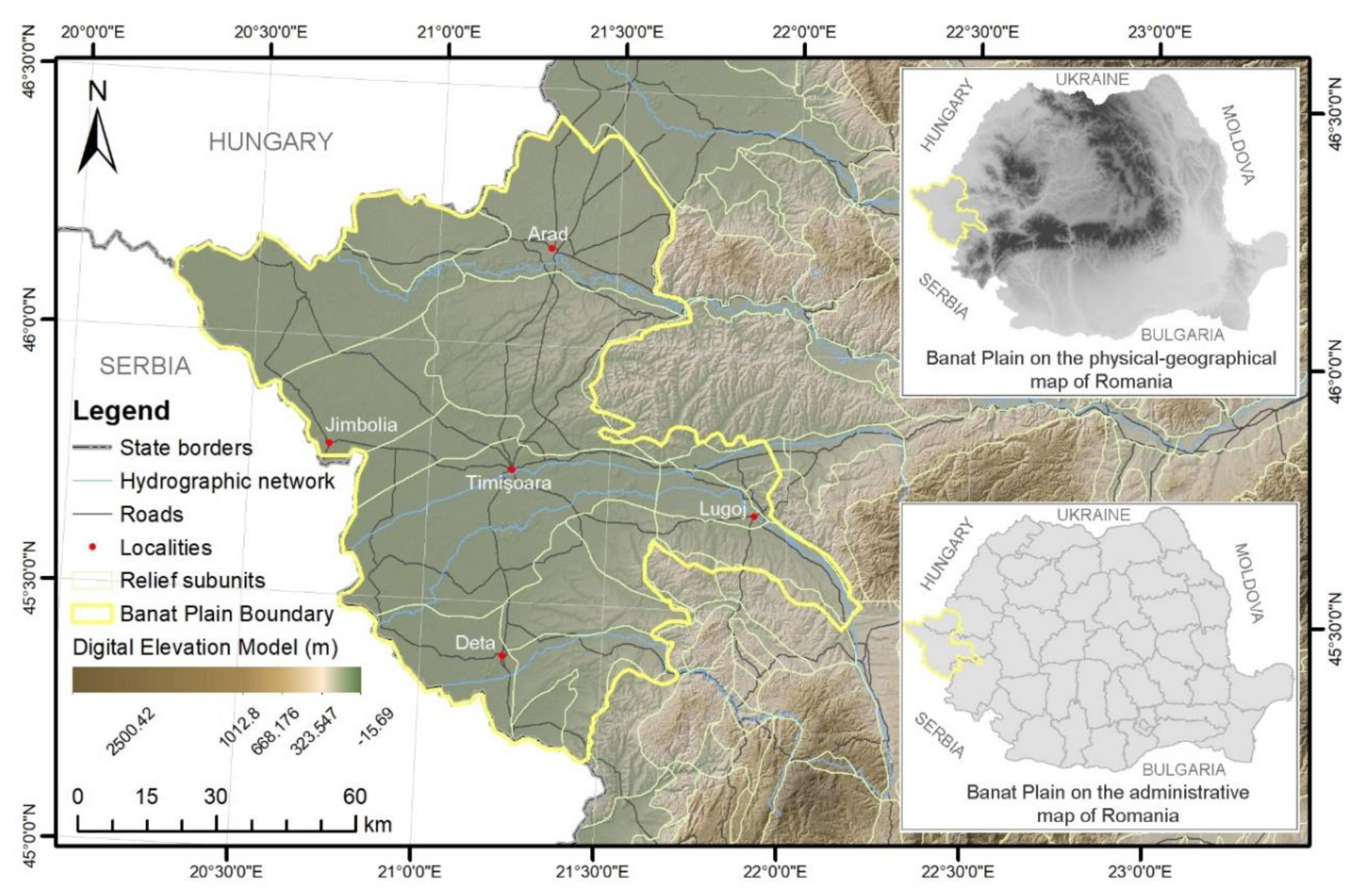Impact of Climate Change in the Banat Plain, Western Romania, on the Accessibility of Water for Crop Production in Agriculture
Abstract
:1. Introduction
2. Materials and Methods
2.1. Study Area
2.2. Data Sources
2.3. Methodology
3. Results and Discussion
3.1. Evolution of the Thermal Regime
3.2. Evolution of the Rainfall Regime
3.3. The Potential Evapotranspiration from the Banat Plain
3.4. Water Accessibility for Plants
4. Conclusions
Author Contributions
Funding
Acknowledgments
Conflicts of Interest
References
- Tadese, M.; Kumar, L.; Koech, R. Long-Term Variability in Potential Evapotranspiration, Water Availability and Drought under Climate Change Scenarios in the Awash River Basin, Ethiopia. Atmosphere 2020, 11, 883. [Google Scholar] [CrossRef]
- Mohammed, R.; Scholz, M. Climate Variability Impact on the Spatiotemporal Characteristics of Drought and Aridityin Arid and Semi-Arid Regions. Water Resour. Manag. 2019, 33, 5015–5033. [Google Scholar] [CrossRef] [Green Version]
- Khan, M.I.; Liu, D.; Fu, Q.; Dong, S.; Liaqat, U.W.; Faiz, M.A.; Hu, Y.; Saddique, Q. Recent Climate Trends and Drought Behavioral Assessment Based on Precipitation and Temperature Data Series in the Songhua River Basin of China. Water Resour. Manag. 2016, 30, 4839–4859. [Google Scholar] [CrossRef]
- Ziernicka-Wojtaszek, A.; Kopcińska, J. Variation in Atmospheric Precipitation in Poland in the Years 2001–2018. Atmosphere 2020, 11, 794. [Google Scholar] [CrossRef]
- Intergovernmental Panel on Climate Change. IPCC Fourth Assessment Report. Climate Change: Synthesis Report; Intergovernmental Panel on Climate Change: Geneva, Switzerland, 2007. [Google Scholar]
- Chen, H.; Guo, S.; Xu, C.-Y.; Singh, V.P. Historical temporal trends of hydro-climatic variables and runoff response to climate variability and their relevance in water resource management in the Hanjiang basin. J. Hydrol. 2007, 344, 171–184. [Google Scholar] [CrossRef]
- Kusangaya, S.; Warburton, M.L.; Van Garderen, E.A.; Jewitt, G.P.W. Impacts of climate change on water resources in southern Africa: A review. Phys. Chem. Earth Parts A/B/C 2014, 67, 47–54. [Google Scholar] [CrossRef]
- Devkota, L.P.; Gyawali, D.R. Impacts of climate change on hydrological regime and water resources management of the Koshi River Basin, Nepal. J. Hydrol. Reg. Stud. 2015, 4, 502–515. [Google Scholar] [CrossRef] [Green Version]
- Heil, K.; Lehner, A.; Schmidhalter, U. Influence of Climate Conditions on the Temporal Development of Wheat Yields in a Long-Term Experiment in an Area with Pleistocene Loess. Climate 2020, 8, 100. [Google Scholar] [CrossRef]
- Lüttger, A.B.; Feike, T. Development of heat and drought related extreme weather events and their effect on winter wheat yields in Germany. Theor. Appl. Clim. 2018, 132, 15–29. [Google Scholar] [CrossRef]
- Gornall, J.; Betts, R.; Burke, E.; Clark, R.; Camp, J.; Willett, K.; Wiltshire, A. Implications of climate change for agricultural productivity in the early twenty-first century. Philos. Trans. R. Soc. B Biol. Sci. 2010, 365, 2973–2989. [Google Scholar] [CrossRef]
- Dahal, V.; Gautam, S.; Bhattarai, R. Analysis of the Long-term Precipitation Trend in Illinois and Its Implications for Agricultural Production. Water 2018, 10, 433. [Google Scholar] [CrossRef] [Green Version]
- Rosenzweig, C.; Tubiello, F.N.; Goldberg, R.; Mills, E.; Bloomfield, J. Increased crop damage in the US from excess precipitation under climate change. Glob. Environ. Chang. 2002, 12, 197–202. [Google Scholar] [CrossRef] [Green Version]
- Foley, A. Uncertainty in regional climate modelling: A review. Prog. Phys. Geogr. Earth Environ. 2010, 34, 647–670. [Google Scholar] [CrossRef] [Green Version]
- Vetter, T.; Reinhardt, J.; Flörke, M.; Van Griensven, A.; Hattermann, F.; Huang, S.; Koch, H.; Pechlivanidis, I.G.; Plötner, S.; Seidou, O.; et al. Evaluation of sources of uncertainty in projected hydrological changes under climate change in 12 large-scale river basins. Clim. Chang. 2017, 141, 419–433. [Google Scholar] [CrossRef]
- Bhaskaran, B.; Ramachandran, A.; Jones, R.; Moufouma-Okia, W. Regional climate model applications on sub-regional scales over the Indian monsoon region: The role of domain size on downscaling uncertainty. J. Geophys. Res. Atmos. 2012, 117, 117. [Google Scholar] [CrossRef]
- Zeng, F.; Ma, M.; Di, D.-R.; Shi, W.-Y. Separating the Impacts of Climate Change and Human Activities on Runoff: A Review of Method and Application. Water 2020, 12, 2201. [Google Scholar] [CrossRef]
- Pachauri, R.K.; Allen, M.R.; Barros, V.R.; Broome, J.; Cramer, W.; Christ, R.; Church, J.A.; Clarke, L.; Dahe, Q.; Dasgupta, P. Contribution of Working Groups I, II and III to the fifth assessment report of the Intergovernmental Panel on Climate Change. In Climate Change 2014: Synthesis Report; IPCC: Geneva, Switzerland, 2014; ISBN 9291691437. [Google Scholar]
- Yang, T.; Wang, C.; Chen, Y.; Chen, X.; Yu, Z. Climate change and water storage variability over an arid endorheic region. J. Hydrol. 2015, 529, 330–339. [Google Scholar] [CrossRef]
- Zhou, J.; Wang, L.; Zhang, Y.; Guo, Y.; Li, X.; Liu, W. Exploring the water storage changes in the largest lake (Selin Co) over the Tibetan Plateau during 2003–2012 from a basin-wide hydrological modeling. Water Resour. Res. 2015, 51, 8060–8086. [Google Scholar] [CrossRef] [Green Version]
- Mojid, M.; Rannu, R.P.; Karim, N.N. Climate change impacts on reference crop evapotranspiration in North-West hydrological region of Bangladesh. Int. J. Clim. 2015, 35, 4041–4046. [Google Scholar] [CrossRef]
- Hess, T. Trends in reference evapo-transpiration in the North East Arid Zone of Nigeria, 1961–1991. J. Arid. Environ. 1998, 38, 99–115. [Google Scholar] [CrossRef]
- Hidalgo, H.G.; Cayan, D.R.; Dettinger, M.D. Sources of Variability of Evapotranspiration in California. J. Hydrometeorol. 2005, 6, 3–19. [Google Scholar] [CrossRef] [Green Version]
- Xu, C.-Y.; Gong, L.; Jiang, T.; Chen, D. Decreasing reference evapotranspiration in a warming climate—A case of Changjiang (Yangtze) River catchment during 1970–2000. Adv. Atmos. Sci. 2006, 23, 513–520. [Google Scholar] [CrossRef]
- Rolim, G.D.S.; Aparecido, L.E. Camargo, Köppen and Thornthwaite climate classification systems in defining climatical regions of the state of São Paulo, Brazil. Int. J. Clim. 2016, 36, 636–643. [Google Scholar] [CrossRef] [Green Version]
- Manabe, S.; Wetherald, R.T.; Milly, P.C.D.; Delworth, T.L.; Stouffer, R.J. Century-Scale Change in Water Availability: CO2-Quadrupling Experiment. Clim. Chang. 2004, 64, 59–76. [Google Scholar] [CrossRef]
- Zhang, Y.; Peña-Arancibia, J.L.; McVicar, T.R.; Chiew, F.H.S.; Vaze, J.; Liu, C.; Lu, X.; Zheng, H.; Wang, Y.-P.; Liu, Y.Y.; et al. Multi-decadal trends in global terrestrial evapotranspiration and its components. Sci. Rep. 2016, 6, 19124. [Google Scholar] [CrossRef] [PubMed] [Green Version]
- Yunusa, I.; Walker, R.; Lu, P. Evapotranspiration components from energy balance, sapflow and microlysimetry techniques for an irrigated vineyard in inland Australia. Agric. For. Meteorol. 2004, 127, 93–107. [Google Scholar] [CrossRef]
- McCabe, M.F.; Ershadi, A.; Jimenez, C.; Miralles, D.G.; Michel, D.; Wood, E.F. The GEWEX LandFlux project: Evaluation of model evaporation using tower-based and globally gridded forcing data. Geosci. Model Dev. 2016, 9, 283–305. [Google Scholar] [CrossRef] [Green Version]
- Tigkas, D.; Vangelis, H.; Tsakiris, G. Implementing Crop Evapotranspiration in RDI for Farm-Level Drought Evaluation and Adaptation under Climate Change Conditions. Water Resour. Manag. 2020, 1–15. [Google Scholar] [CrossRef]
- Kume, T.; Tanaka, N.; Kuraji, K.; Komatsu, H.; Yoshifuji, N.; Saitoh, T.M.; Suzuki, M.; Kumagai, T. Ten-year evapotranspiration estimates in a Bornean tropical rainforest. Agric. For. Meteorol. 2011, 151, 1183–1192. [Google Scholar] [CrossRef]
- Vernimmen, R.; Bruijnzeel, L.; Romdoni, A.; Proctor, J. Rainfall interception in three contrasting lowland rain forest types in Central Kalimantan, Indonesia. J. Hydrol. 2007, 340, 217–232. [Google Scholar] [CrossRef]
- Montazar, A.; Krueger, R.; Corwin, D.L.; Pourreza, A.; Little, C.; Rios, S.; Snyder, R.L. Determination of Actual Evapotranspiration and Crop Coefficients of California Date Palms Using the Residual of Energy Balance Approach. Water 2020, 12, 2253. [Google Scholar] [CrossRef]
- Allen, R.; Pruitt, W.O.; Wright, J.L.; Howell, T.A.; Ventura, F.; Snyder, R.; Itenfisu, D.; Steduto, P.; Berengena, J.; Yrisarry, J.B.; et al. A recommendation on standardized surface resistance for hourly calculation of reference ETo by the FAO56 Penman-Monteith method. Agric. Water Manag. 2006, 81, 1–22. [Google Scholar] [CrossRef]
- Payero, J.O.; Neale, C.M.U.; Wright, J.L.; Allen, R.G. Guidelines for validating Bowen ratio data. Trans. ASABE 2003, 46, 1051. [Google Scholar] [CrossRef]
- Farahani, H.J.; Howell, T.A.; Shuttleworth, W.J.; Bausch, W.C. Evapotranspiration: Progress in Measurement and Modeling in Agriculture. Trans. ASABE 2007, 50, 1627–1638. [Google Scholar] [CrossRef]
- Allen, R.G.; Pereira, L.S.; Howell, T.A.; Jensen, M.E. Evapotranspiration information reporting: I. Factors governing measurement accuracy. Agric. Water Manag. 2011, 98, 899–920. [Google Scholar] [CrossRef] [Green Version]
- Marino, G.; Zaccaria, D.; Snyder, R.L.; Lagos, O.; Lampinen, B.; Ferguson, L.; Grattan, S.R.; Little, C.; Shapiro, K.; Maskey, M.L.; et al. Actual Evapotranspiration and Tree Performance of Mature Micro-Irrigated Pistachio Orchards Grown on Saline-Sodic Soils in the San Joaquin Valley of California. Agric. 2019, 9, 76. [Google Scholar] [CrossRef] [Green Version]
- Bhantana, P.; Lazarovitch, N. Evapotranspiration, crop coefficient and growth of two young pomegranate (Punica granatum L.) varieties under salt stress. Agric. Water Manag. 2010, 97, 715–722. [Google Scholar] [CrossRef]
- Eurostat. Available online: https://ec.europa.eu/eurostat/web/gisco/geodata/reference-data/administrative-units-statistical-units/countries (accessed on 6 September 2020).
- European Environment Agency (EEA). Available online: https://www.eea.europa.eu/data-and-maps (accessed on 6 September 2020).
- Posea, G. Romanian Plains—Banato-Crişana Plain; Part IV, Banat Plain; Bucharest University Typography: Bucharest, Romania, 1992; pp. 32–67. [Google Scholar]
- Hammer, Ø. Manual Reference PAleontological Statistics Version 4.03. Available online: https://www.nhm.uio.no/english/research/infrastructure/past/downloads/past4manual.pdf (accessed on 1 September 2020).
- Niemeyer, S. New Drought Indexes. Options Mediterranean. Série A Séminaires Méditerranéens 2008, 80, 267–274. [Google Scholar]
- Lloyd-Hughes, B. The impracticality of a universal drought definition. Theor. Appl. Clim. 2014, 117, 607–611. [Google Scholar] [CrossRef] [Green Version]
- Aguilos, M.; Stahl, C.; Burban, B.; Hérault, B.; Courtois, E.; Coste, S.; Wagner, F.; Ziegler, C.; Takagi, K.; Bonal, D. Interannual and Seasonal Variations in Ecosystem Transpiration and Water Use Efficiency in a Tropical Rainforest. Forest 2019, 10, 14. [Google Scholar] [CrossRef] [Green Version]
- Boese, S.; Jung, M.; Carvalhais, N.; Reichstein, M. The importance of radiation for semiempirical water-use efficiency models. Biogeosciences 2017, 14, 3015–3026. [Google Scholar] [CrossRef] [Green Version]
- González, J.; Valdés, J.B. New drought frequency index: Definition and comparative performance analysis. Water Resour. Res. 2006, 42. [Google Scholar] [CrossRef]
- Tsakiris, G.; Pangalou, D.; Vangelis, H. Regional Drought Assessment Based on the Reconnaissance Drought Index (RDI). Water Resour. Manag. 2007, 21, 821–833. [Google Scholar] [CrossRef]
- Vicente-Serrano, S.M.; Beguería, S.; López-Moreno, J.I. A Multiscalar Drought Index Sensitive to Global Warming: The Standardized Precipitation Evapotranspiration Index. J. Clim. 2010, 23, 1696–1718. [Google Scholar] [CrossRef] [Green Version]
- Visitiu, O.-P.; Calcium, I.C.; Simota, C.C. Drought Intensity on Arable Land in Romania—Processes and Tendencies; The works of the Dimitrie Cantemir Geographic Seminary; Alexandru Ioan Cuza University Publishing House: Iași, Romania, 2016; Volume 42, pp. 67–80. [Google Scholar] [CrossRef]
- FAO Unesco. World of Desertification. Available online: http://www.fao.org/3/T0115E06.htm (accessed on 4 September 2020).
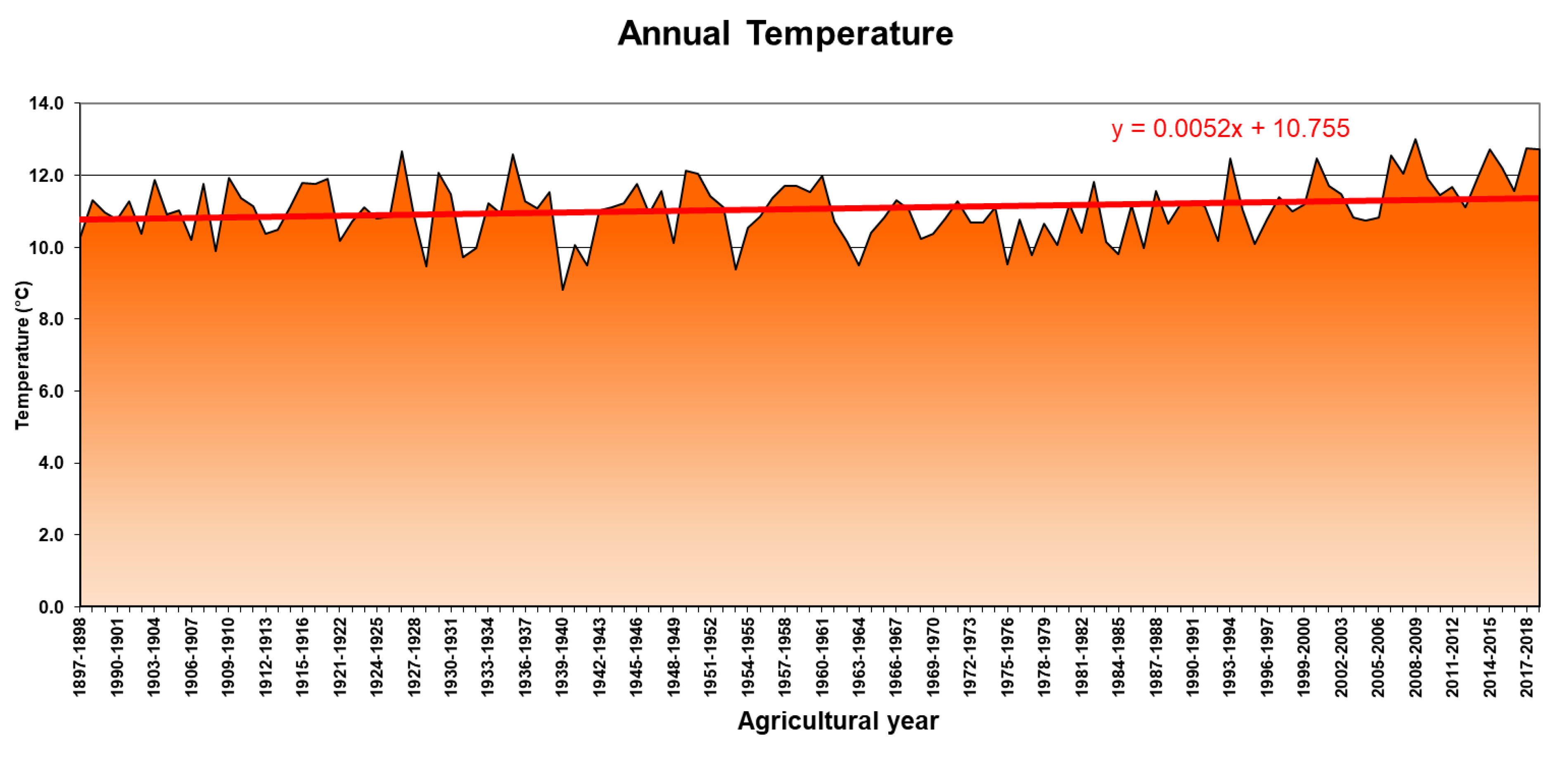
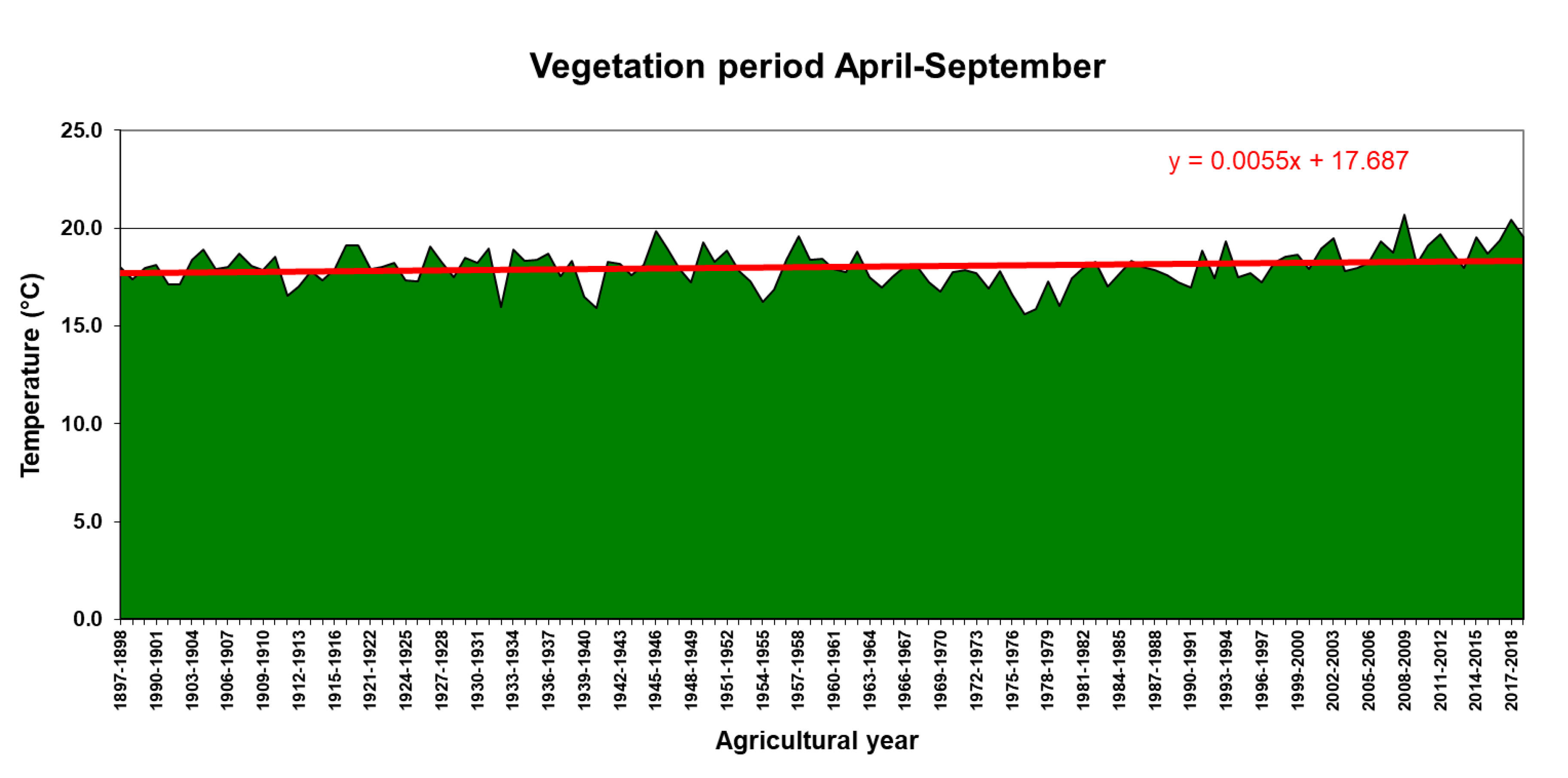
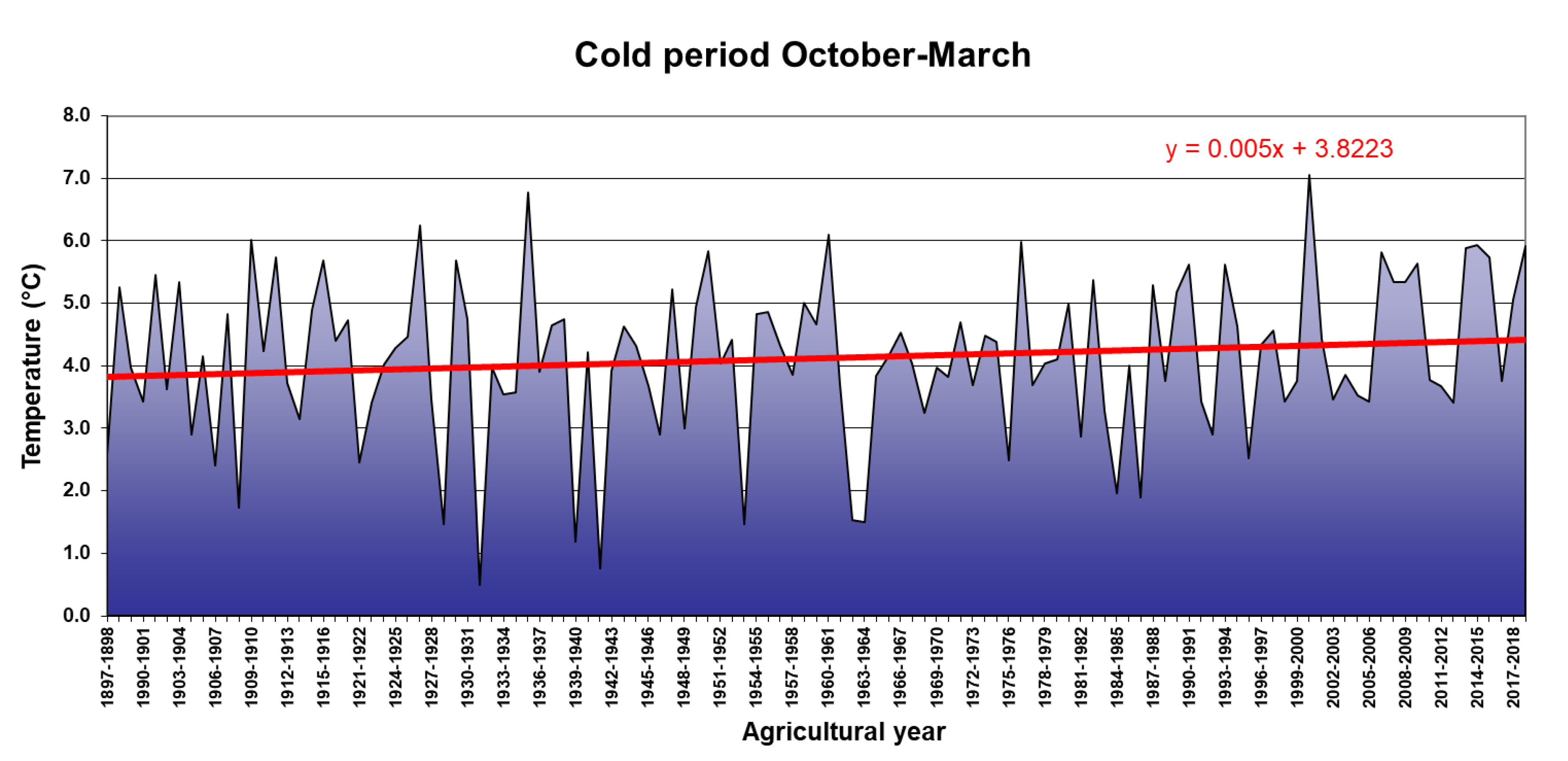
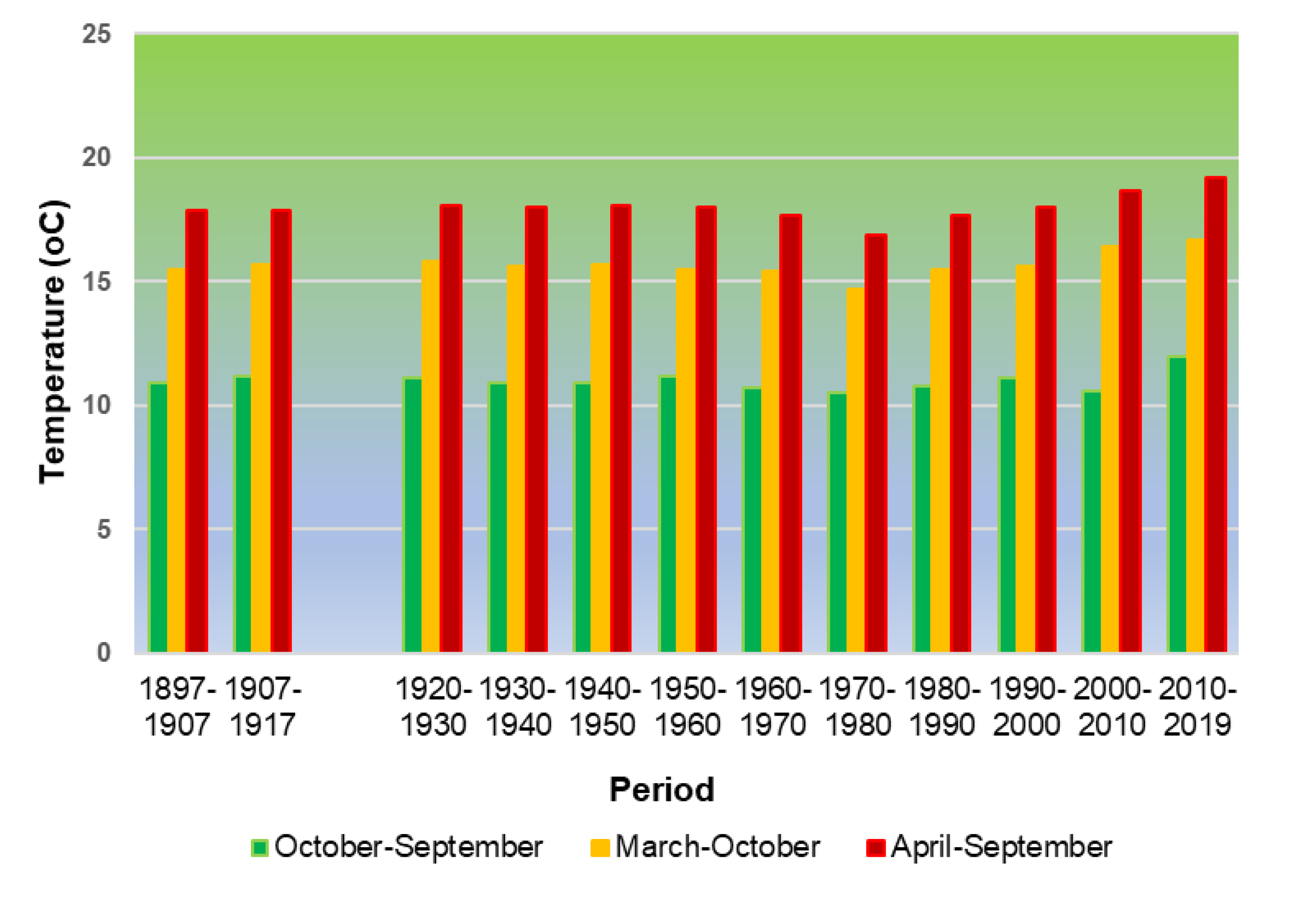
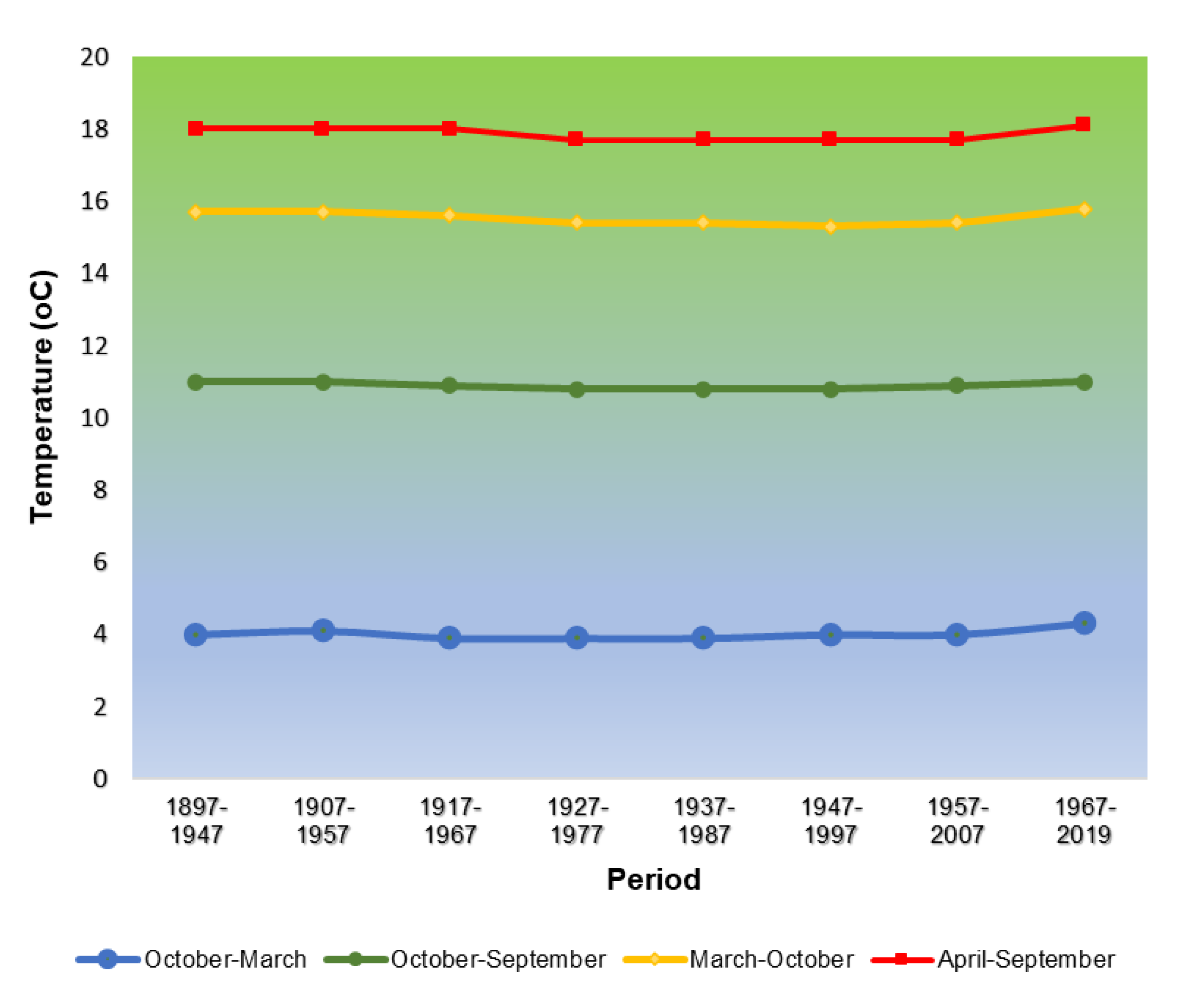
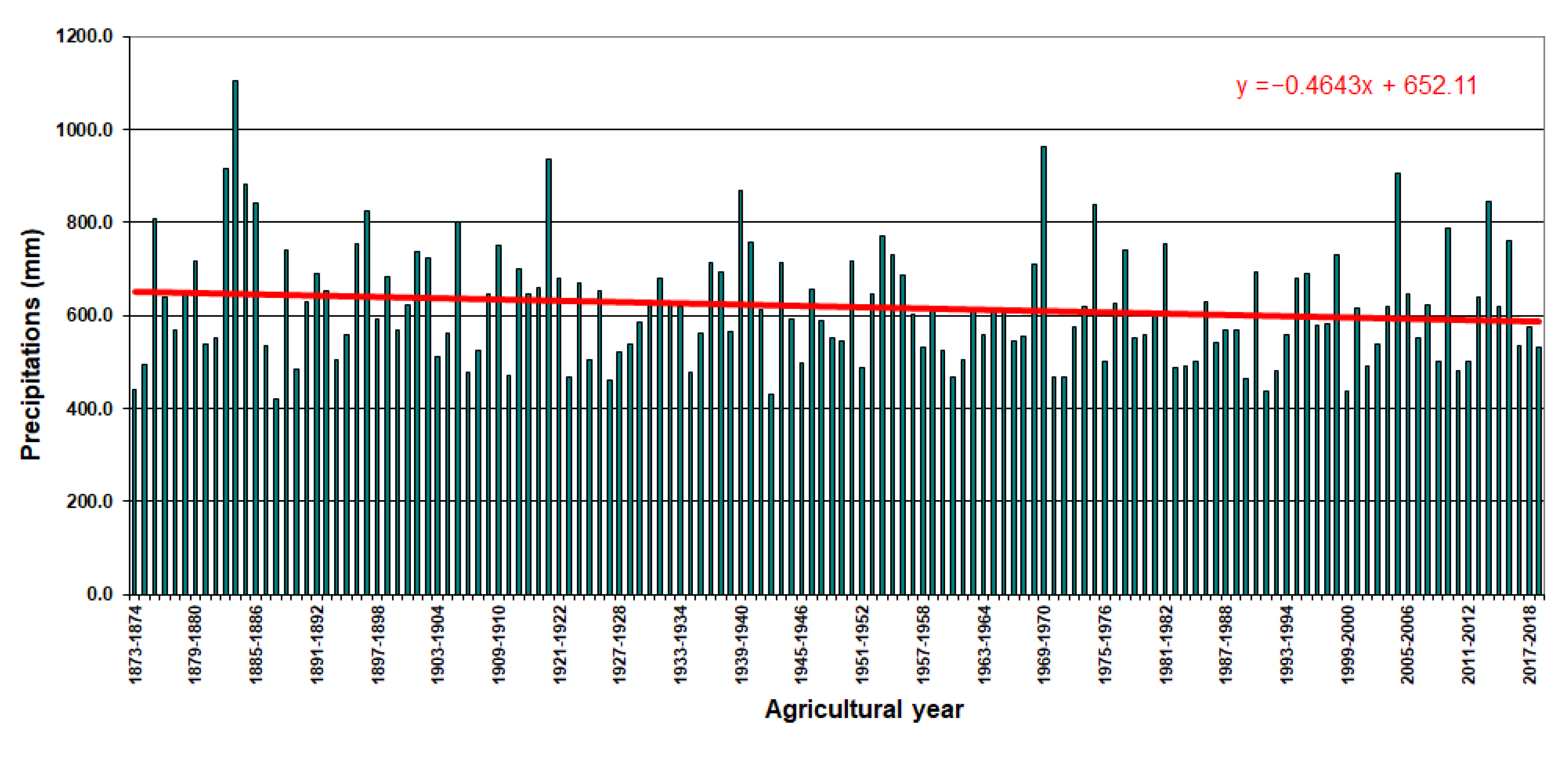
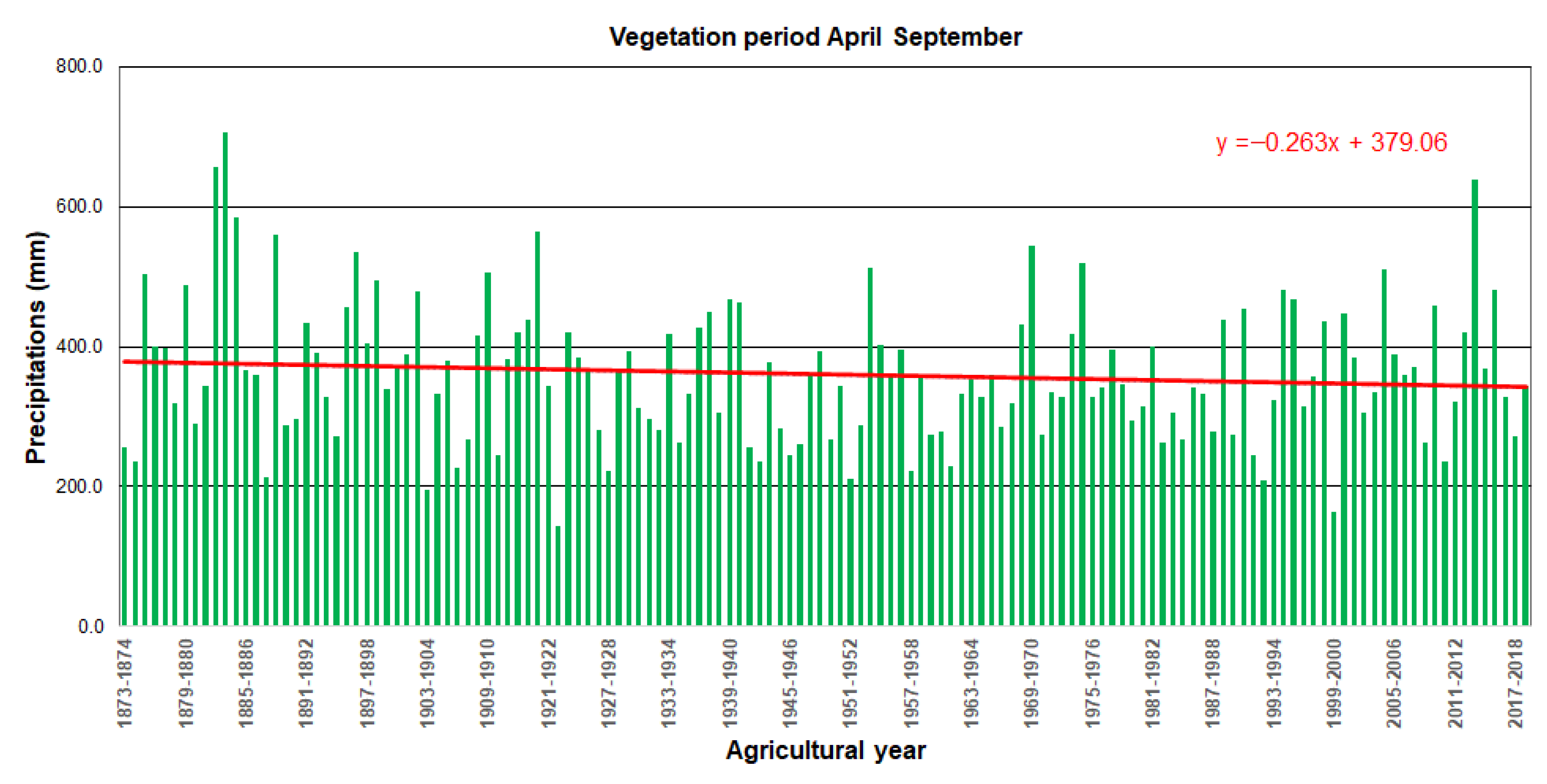
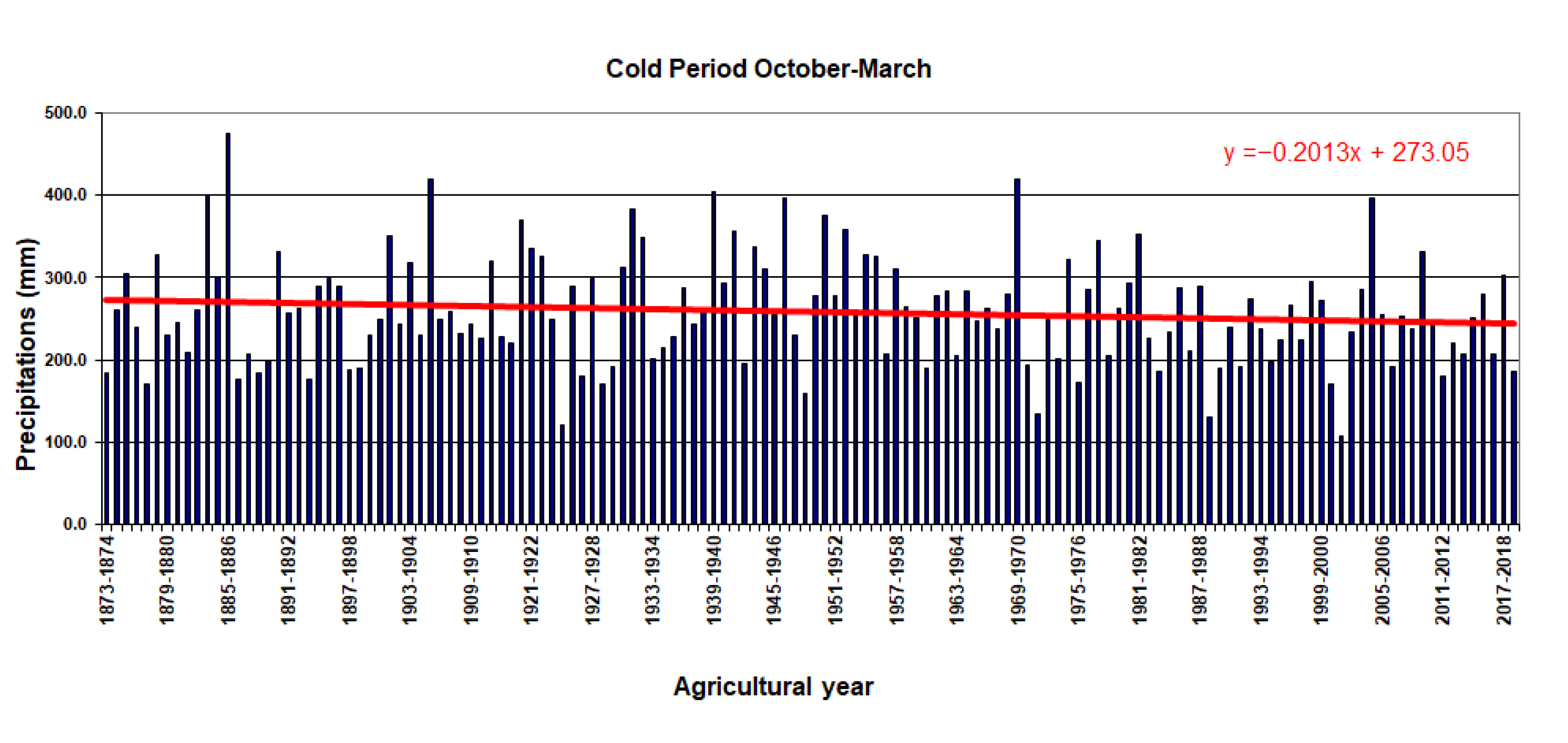
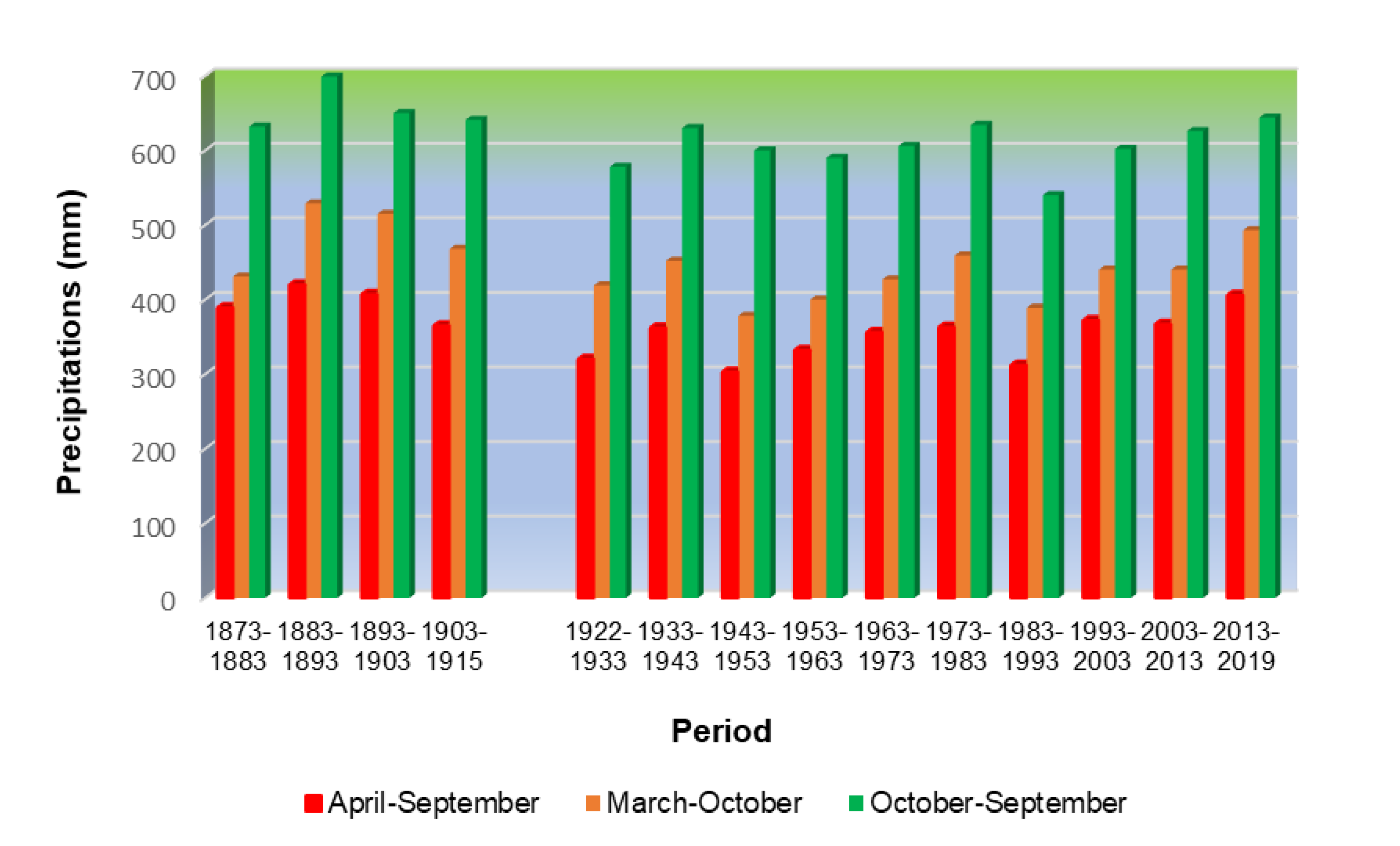
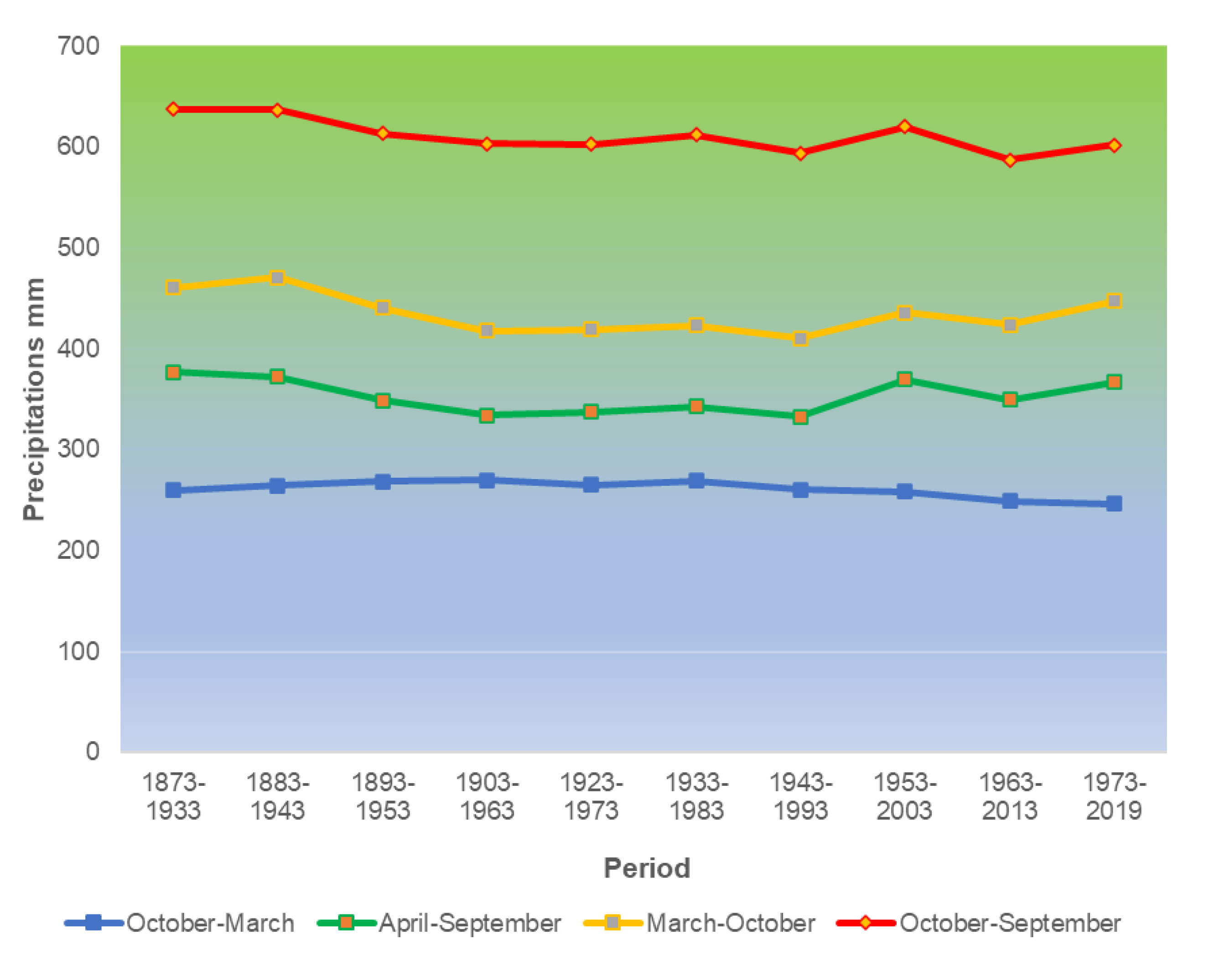
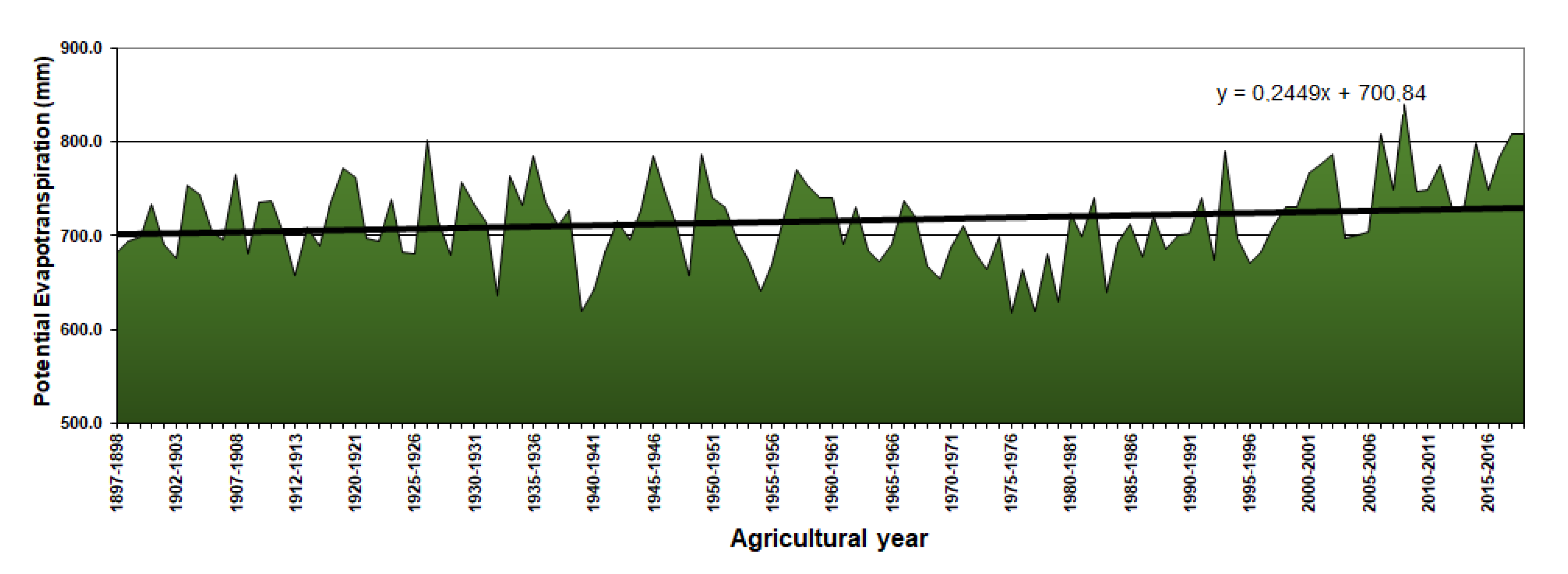
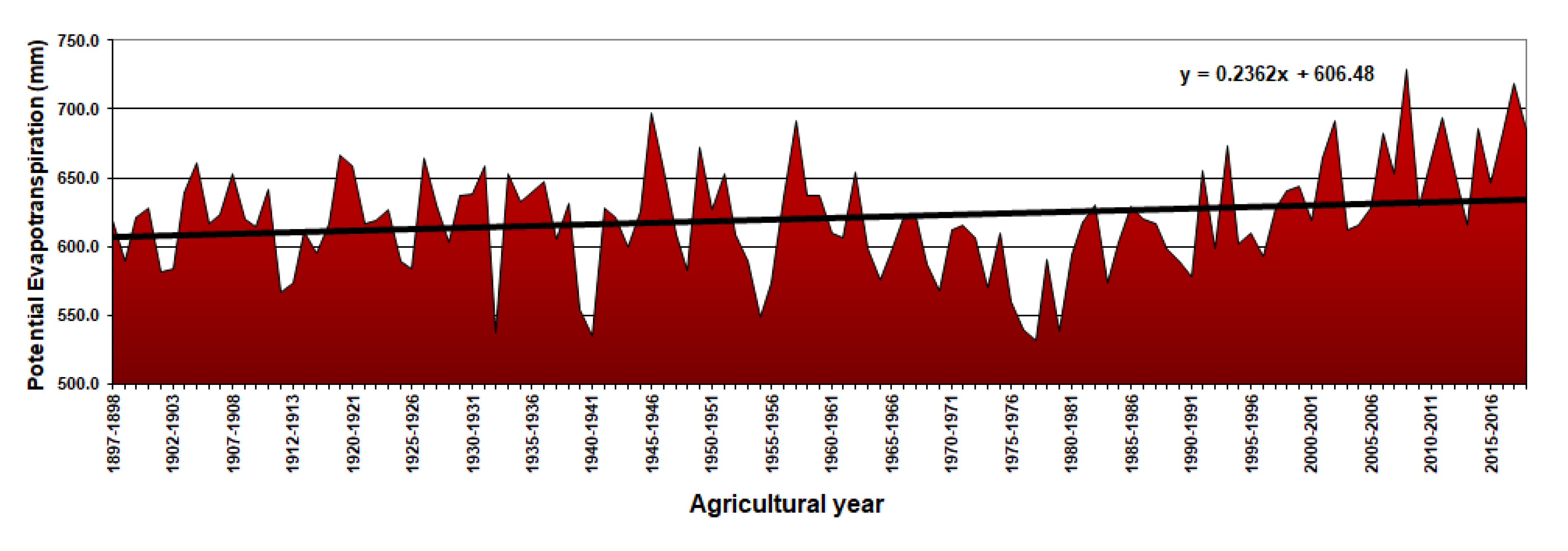
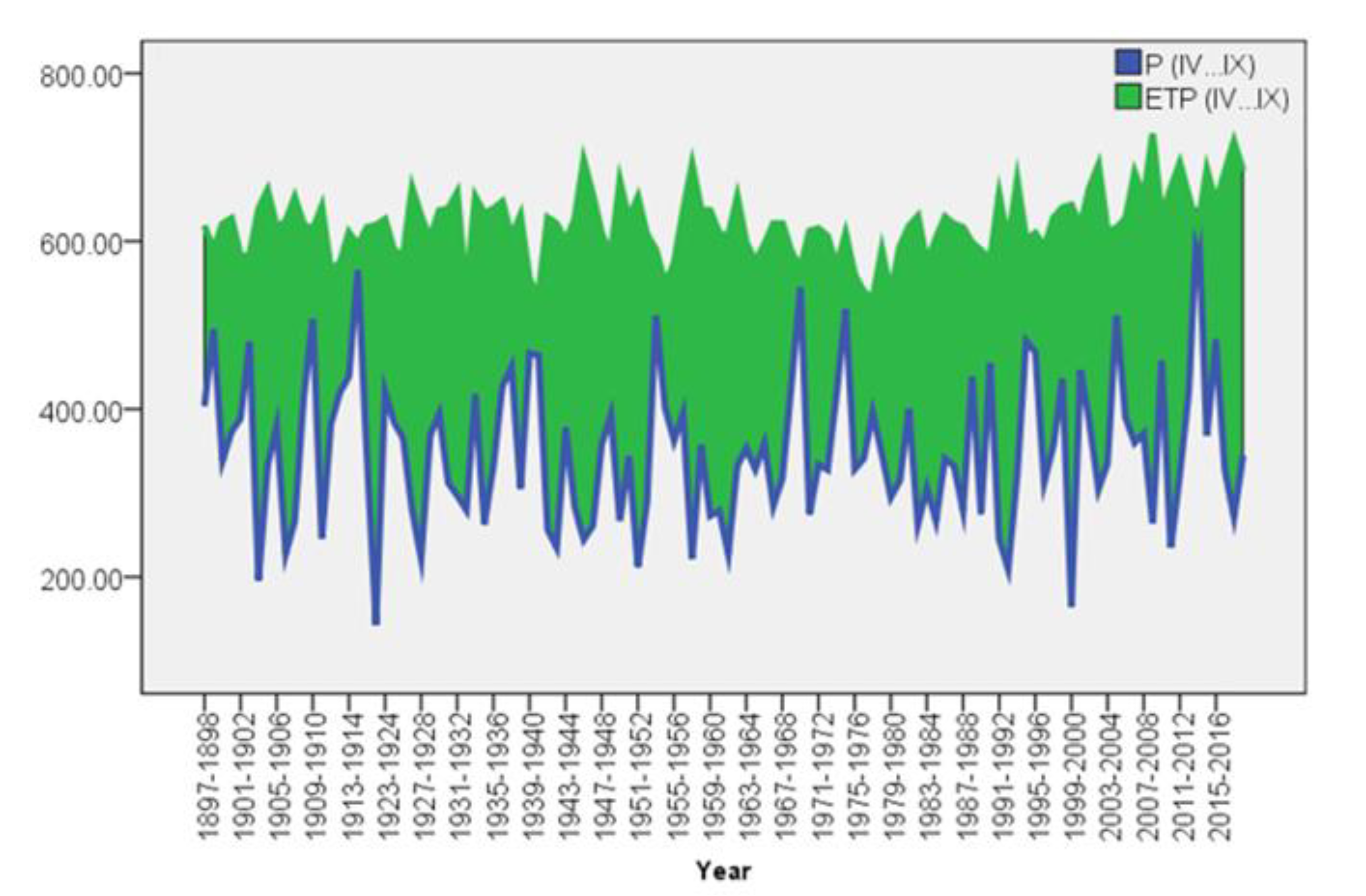
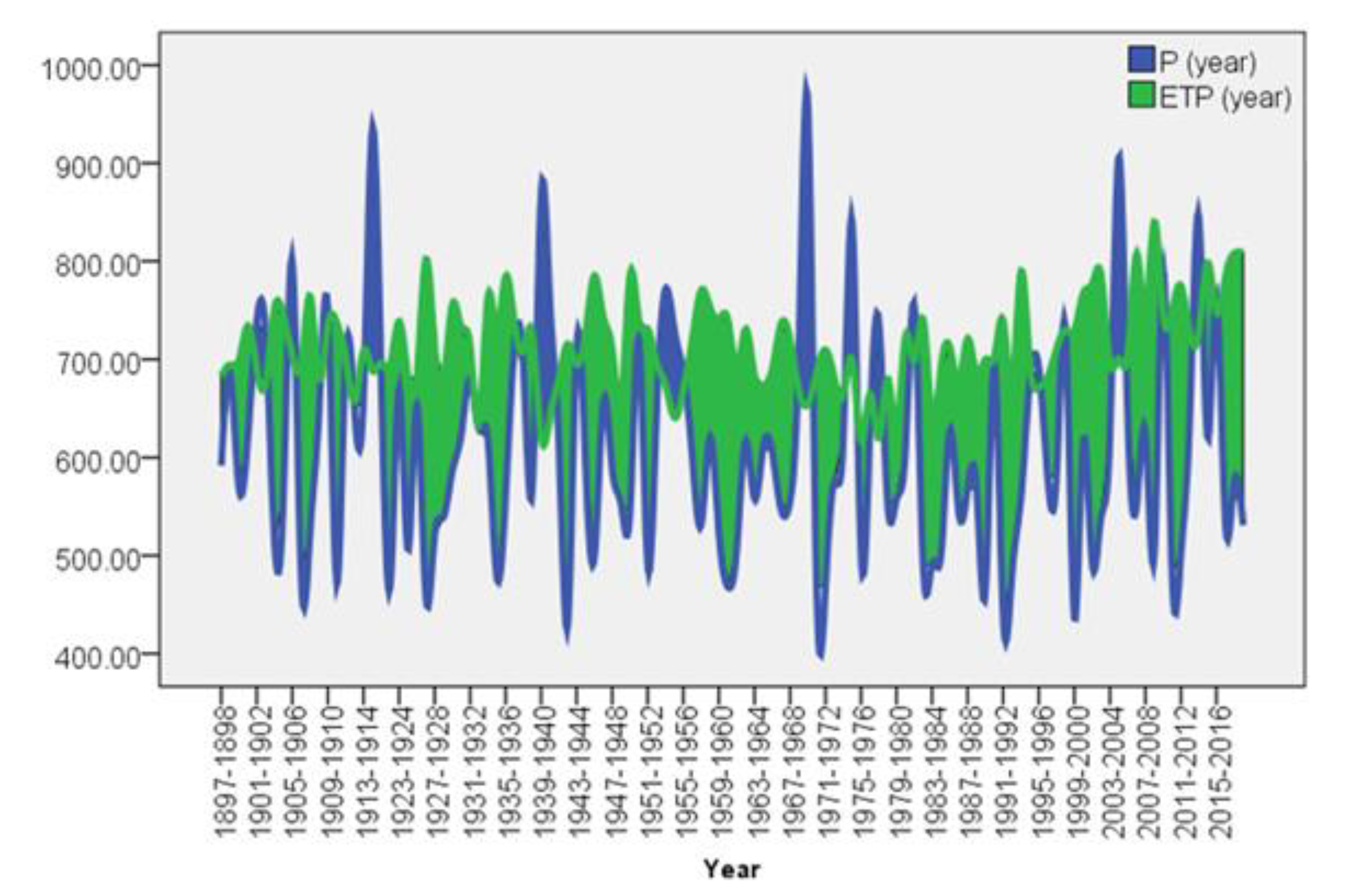
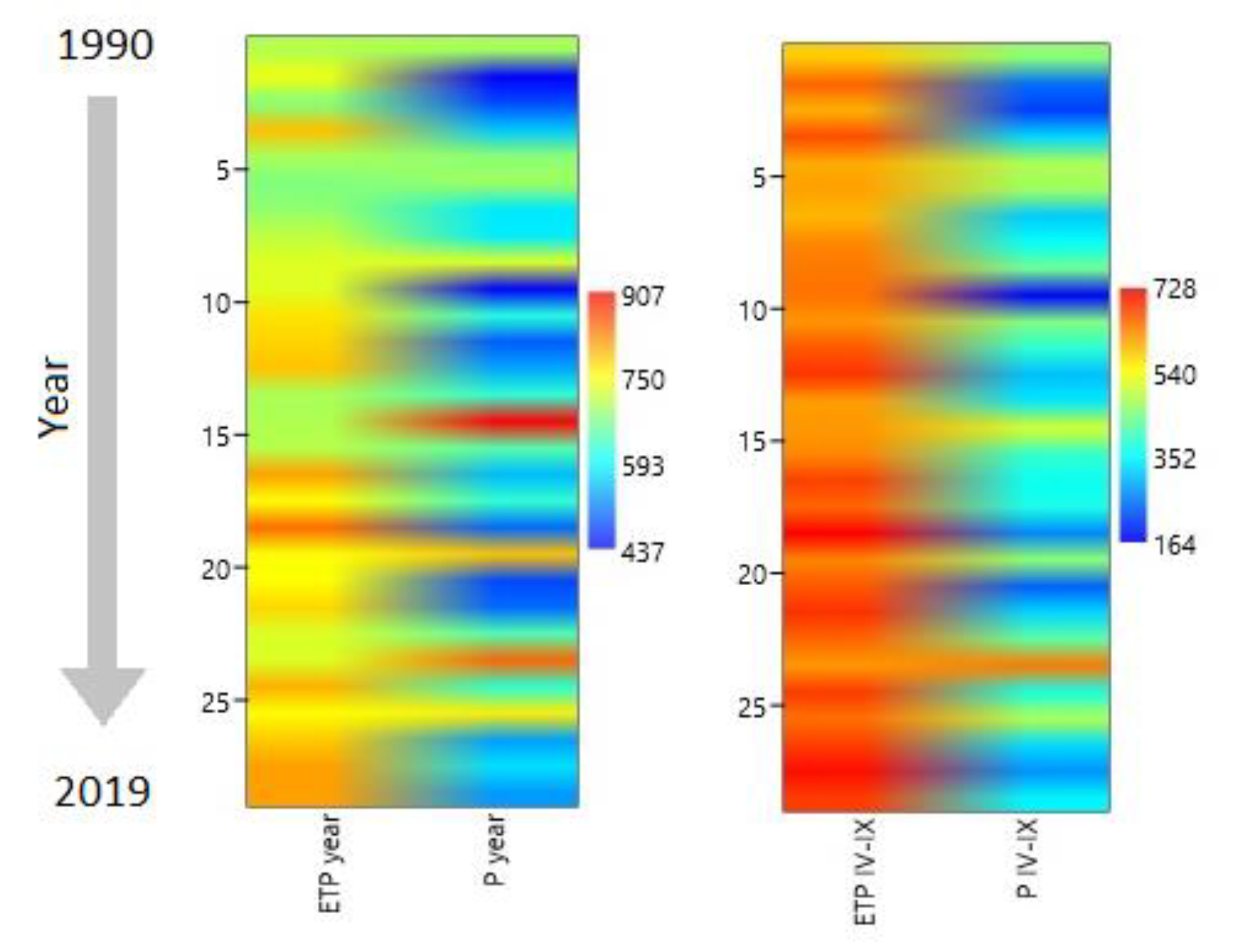
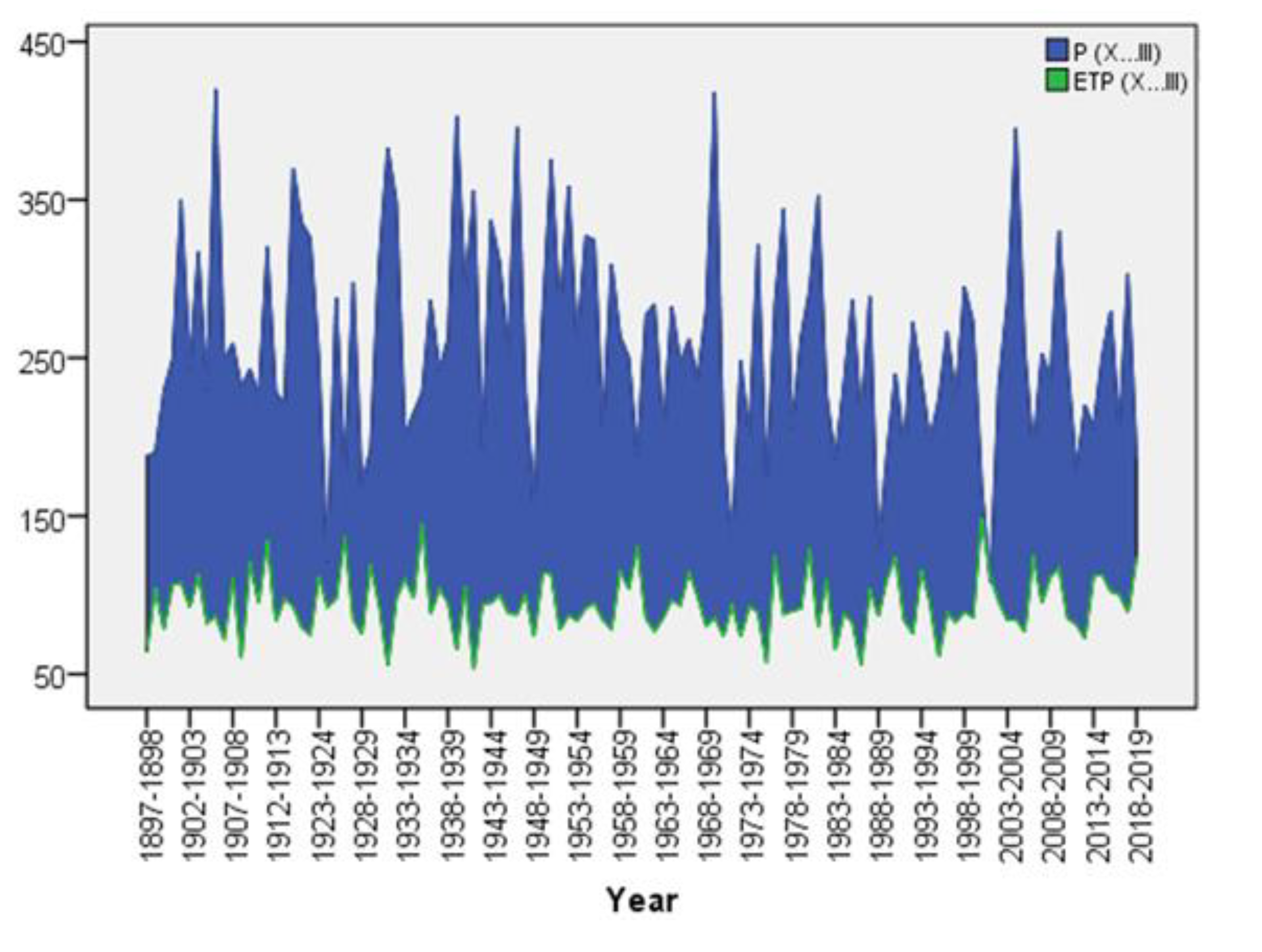
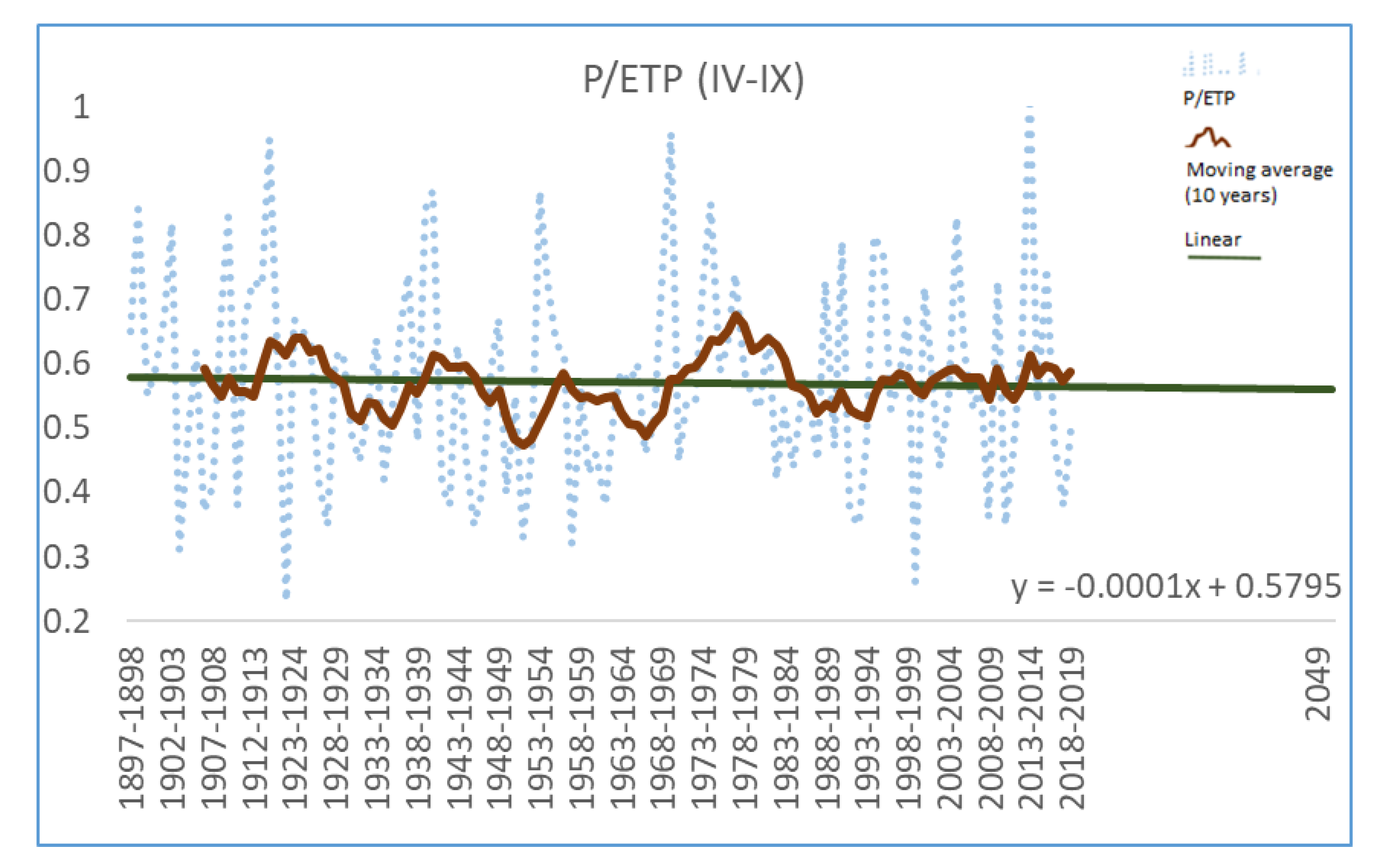
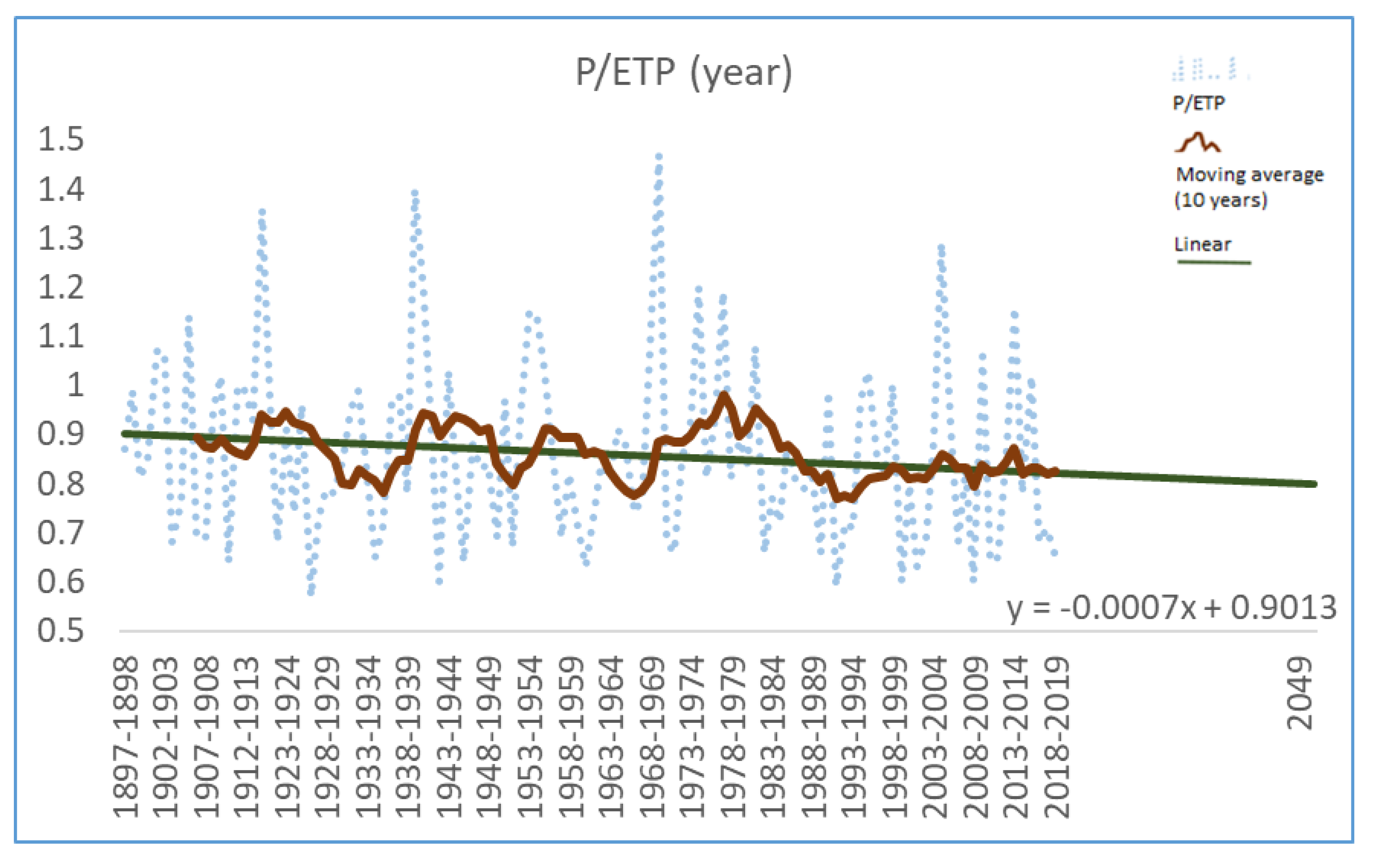

| Statistic Series | Time Period (Years) | Mean | Lower Bound of 95% Confidence Interval for Mean | Upper Bound of 95% Confidence Interval for Mean | Minimum | Maximum |
|---|---|---|---|---|---|---|
| ETP (IV… IX) | 1898–1950 | 617.7 | 607.8661 | 627.6998 | 535.70 | 696.60 |
| 1951–1989 | 602.6 | 591.6307 | 613.5847 | 532.00 | 691.80 | |
| 1990–2019 | 645.9 | 631.3340 | 660.5727 | 578.00 | 728.30 | |
| 1898–2019 | 619.9 | 612.8386 | 627.0942 | 532.00 | 728.30 | |
| P (IV… IX) | 1898–1950 | 350.5 | 323.7589 | 377.3773 | 142.70 | 565.00 |
| 1951–1989 | 342.3 | 317.4843 | 367.1464 | 212.20 | 544.60 | |
| 1990–2019 | 365.4 | 327.3502 | 403.6098 | 164.30 | 639.50 | |
| 1898–2019 | 351.6 | 335.2176 | 368.0824 | 142.70 | 639.50 | |
| ETP (year) | 1898–1950 | 712.5 | 700.7053 | 724.3330 | 619.70 | 801.40 |
| 1951–1989 | 693.9 | 681.7718 | 706.1923 | 617.40 | 770.40 | |
| 1990–2019 | 744.2 | 727.1872 | 761.2595 | 671.20 | 840.20 | |
| 1898–2019 | 714.4 | 706.2282 | 722.7442 | 617.40 | 840.20 | |
| P (year) | 1898–1950 | 618.8 | 587.0006 | 650.7484 | 430.00 | 935.00 |
| 1951–1989 | 604.0 | 568.3505 | 639.8239 | 468.00 | 963.00 | |
| 1990–2019 | 603.8 | 559.3991 | 648.2542 | 436.80 | 906.70 | |
| 1898–2019 | 610.0 | 589.5698 | 630.4526 | 430.00 | 963.00 |
| Statistics Series | (I) Time Period | (J) Time Period | Mean Difference (I–J) | p (Sig.) |
|---|---|---|---|---|
| ETP (IV… IX) | 1898–1950 | 1951–1989 | 15.17529 | 0.120 |
| 1990–2019 | −28.17035 * | 0.003 | ||
| 1951–1989 | 1898–1950 | −15.17529 | 0.120 | |
| 1990–2019 | −43.34564 * | 0.000 | ||
| 1990–2019 | 1898–1950 | 28.17035 * | 0.003 | |
| 1951–1989 | 43.34564 * | 0.000 | ||
| ETP (year) | 1898–1950 | 1951–1989 | 18.53710 | 0.096 |
| 1990–2019 | −31.70418 * | 0.003 | ||
| 1951–1989 | 1898–1950 | −18.53710 | 0.096 | |
| 1990–2019 | −50.24128 * | 0.000 | ||
| 1990–2019 | 1898–1950 | 31.70418 * | 0.003 | |
| 1951–1989 | 50.24128 * | 0.000 |
| Statistic Series | Frequency (Number of Years) | Percentage | Cumulative Percentage |
|---|---|---|---|
| P/ETP (IV_IX) | |||
| 0.20 | 1 | 0.9 | 0.9 |
| 0.50 | 31 | 26.7 | 50.0 |
| 1.00 | 2 | 1.7 | 100.0 |
| Total | 116 | 100.0 | |
| P/ETP (year) | |||
| 0.60 | 11 | 9.5 | 9.5 |
| 1.00 | 18 | 15.5 | 86.2 |
| 1.50 | 1 | 0.9 | 100.0 |
| Total | 116 | 100.0 |
© 2020 by the authors. Licensee MDPI, Basel, Switzerland. This article is an open access article distributed under the terms and conditions of the Creative Commons Attribution (CC BY) license (http://creativecommons.org/licenses/by/4.0/).
Share and Cite
Şmuleac, L.; Rujescu, C.; Șmuleac, A.; Imbrea, F.; Radulov, I.; Manea, D.; Ienciu, A.; Adamov, T.; Pașcalău, R. Impact of Climate Change in the Banat Plain, Western Romania, on the Accessibility of Water for Crop Production in Agriculture. Agriculture 2020, 10, 437. https://doi.org/10.3390/agriculture10100437
Şmuleac L, Rujescu C, Șmuleac A, Imbrea F, Radulov I, Manea D, Ienciu A, Adamov T, Pașcalău R. Impact of Climate Change in the Banat Plain, Western Romania, on the Accessibility of Water for Crop Production in Agriculture. Agriculture. 2020; 10(10):437. https://doi.org/10.3390/agriculture10100437
Chicago/Turabian StyleŞmuleac, Laura, Ciprian Rujescu, Adrian Șmuleac, Florin Imbrea, Isidora Radulov, Dan Manea, Anișoara Ienciu, Tabita Adamov, and Raul Pașcalău. 2020. "Impact of Climate Change in the Banat Plain, Western Romania, on the Accessibility of Water for Crop Production in Agriculture" Agriculture 10, no. 10: 437. https://doi.org/10.3390/agriculture10100437
APA StyleŞmuleac, L., Rujescu, C., Șmuleac, A., Imbrea, F., Radulov, I., Manea, D., Ienciu, A., Adamov, T., & Pașcalău, R. (2020). Impact of Climate Change in the Banat Plain, Western Romania, on the Accessibility of Water for Crop Production in Agriculture. Agriculture, 10(10), 437. https://doi.org/10.3390/agriculture10100437








